Content
- 1 Cucumber varieties
- 2 When to sow seeds
- 3 Temperature and watering during cultivation
- 4 Land requirements
- 5 Seed preparation and sowing
- 6 Sowing seeds
- 7 Growing cucumbers
- 8 Features of watering and feeding
- 9 The best varieties of cucumbers for growing on a windowsill
- 10 The main rules for healthy cucumber seedlings
- 11 Cucumber planting utensils
- 12 Care rules
- 13 Growing problems
What plants need to be grown on the windowsill so that the flowers are beautiful, and the leaves refresh the air with oxygen, and the fruits can be used for making salads? And, all this to have all year round? This wonderful plant is called a cucumber. In order to have the expected effect, you need theoretical knowledge, a little practical experience in growing any indoor plants and a great desire. The proposed article is designed for those readers who, after receiving new information, do not forget it, but try to use the theory in practice. What do you need to know to have cucumbers on the windowsill all winter?
Cucumbers on the windowsill
Cucumber varieties
Let's start with pure theory. To obtain fruit, the vast majority of flowers must be pollinated by insects; this natural process has many features and differences. In the rooms, as you might guess, flies, bees, butterflies and other insects do not fly in swarms. Especially in winter.
For the windowsill, you need to choose parthenocarpic varieties
Conclusion. For growing on a windowsill, you need to take only special hybrid varieties of cucumbers that do not require natural pollination. Such plants are scientifically called parthenocarpic, they do not need pollination. This is a very important factor, do not even try to plant ordinary cucumbers on the windowsill, intended for growing in the beds. Whatever yield you are promised on a package of seeds, you will have zero yield in your apartment.
In stores you can find quite a few varieties of cucumbers intended for indoor cultivation, it is not worth listing them. Pay attention to this feature when buying.
Parthenocarpic cucumbers: popular hybrids
When to sow seeds
This issue should be discussed in more detail. The fact is that you want to have cucumbers all winter, and not just a few days. And for this, theoretical knowledge will be useful again.
When to sow seeds
From germination to the beginning of fruiting takes about 45-50 days, the period of fruiting of one plant is about a month and a half. This means that one-time sowing of cucumbers is not enough. If you want to have fresh fruits for 4–5 months, you will have to deal with plant seedlings at least four times. The gap between crops is a month and a half. As soon as the first wave ceases to bear fruit, the fruiting of the "second stage" begins, and so on.
It should take about two weeks between sowing.
With time and the frequency of sowing, we figured it out, excellent. But now you need to take into account the "number of windowsills" for the placement of cucumbers. If you have enough for each "queue" one bush, then there should be no problems. You can always place 5-6 cucumber bushes in an apartment. And if you want to collect a relatively large number of cucumbers, then one bush for each "queue" is not enough. Here you will have to choose between the amount of short-term picking of cucumbers and the duration.
Practical advice. In one standard box for indoor plants with a length of 70 centimeters, you can place no more than 6 cucumber bushes. Keep this in mind when calculating the total number of bushes and seeding periods.
You can sow seeds from September. In this case, the first fruits will be already at the end of October and beginning of December.Then, after one and a half two months, plant new plants again. At the same time, you need to know that daylight hours for cucumbers should last at least 14-15 hours; in winter, artificial lighting is indispensable.
In winter, cucumbers need additional lighting
Temperature and watering during cultivation
The temperature in the room during the day should be within + 21–24 ° С, at night + 18–19 ° С. In most apartments, this is the temperature that is maintained during the winter period. If not, the plants need to be slightly warmed up with any devices, including incandescent lamps. They will illuminate and warm at the same time. As far as energy losses are concerned, there are no problems here. Less energy is always required to heat a window sill with cucumbers than for the entire room. Of course, it is advisable to place the plants on the south side.
For good fruiting, you need to observe the temperature regime
Soil moisture has a significant impact not only on yield, but also on plant health. Not enough moisture - there are few cucumbers and their appearance is poor. A lot of moisture, and even at insufficient temperatures, will certainly lead to decay of the horse system and the death of cucumbers. The plant should be watered in a timely manner, but without excessive fanaticism. It should also be borne in mind that on the windowsills, the earth quickly loses moisture, for cucumbers this is unacceptable. Experienced growers strongly recommend sprinkling the leaves with clean, warm water daily. And so that the roots do not rot, all containers must have an effective drainage system.
Spray cucumbers with warm water additionally
Land requirements
The best option is to purchase a ready-made universal mixture in specialized stores. This is a clean land, excellent for cucumbers in terms of fertility.
Soil for cucumbers
You can also prepare the mixture yourself.
We recommend the following formulations:
- two parts of coconut fiber and one part of vermicompost. The land is quite fashionable today, although it does not have any particular advantages. Expensive coconut fiber can be successfully replaced with overripe sawdust of deciduous trees, and purchased vermicompost with humus;
Biohumus and coconut flakes
- mix two parts of garden land with one part of river sand and one part of humus. If the soil is too "greasy", then sawdust can be added.
Add sand and humus to the garden soil
Self-prepared soil must be decontaminated. This can be done by heating in an oven up to + 120 ° С for 30–40 minutes or using liquid solutions. A weak solution of potassium permanganate or any commercial chemicals will do. Some gardeners recommend spilling the ground with boiling water, but the effectiveness of this method is insufficient, and cucumbers are very afraid of pests and diseases in the ground.
Calcining the soil in the oven
Seed preparation and sowing
If you bought expensive seeds, then they have special shells of nutrients, have been treated and stimulated growth. They can be sown immediately, no additional preparation is required. If the seeds are ordinary, then they should be prepared for germination. The preparation consists of several stages.
- Disinfection. You can use a solution of pink potassium permanganate. The seeds are soaked in it for 2-3 hours. No potassium permanganate - use hydrogen peroxide or boric acid. A solution of 3-4% concentration is made of them, the soaking time is up to thirty minutes. In stores, compositions for disinfection are sold, you can also use them. During the procedure, the seeds are washed with clean running water.
Disinfection of cucumber seeds
- Stimulating growth. You can buy a special composition in the store, or you can make it yourself from aloe juice. To do this, dilute 20 ml of juice in 100 ml of water. The seeds should remain in the solution for approximately 4-5 hours.
Soaking cucumber seeds in a nutrient solution
- Soak... Experienced growers recommend not skipping this operation. It will take a little time, and the result will be very positive. Thanks to soaking, it is possible to select the strongest shoots, to completely exclude the sowing of non-viable seeds. In addition, soaking avoids diving, which the plants have a negative attitude towards. Diving significantly slows down growth, small roots are necessarily damaged.
Soaking cucumber seeds
Sowing seeds
You can sow both germinated after soaking, and ordinary seeds. First, consider the technology of sowing germinated seeds.
After small roots have appeared on the seeds, they can be transplanted into the ground. In the ground, make small holes about two centimeters deep, lower the seeds with the root down and sprinkle them gently. It goes without saying that the soil should be moist and after sowing it should be watered with a sprinkler. Cover the container with a plastic wrap or thick cloth and place in a warm place for germination.
Sowing cucumber seeds
Without soaking, the seeds are sown in this way, only in one hole you need at least two sweets. Nobody knows how many seeds will eventually viable, you should not risk time and, in case of problems, re-sowing.
After two real leaves have appeared, the soil in the pots is poured two or three centimeters. This operation improves the conditions for the development of the root system.
Healthy seedlings of cucumber seeds in the soil
Growing cucumbers
In the early stages of growth, it is recommended to light the plants evenly from all directions. To do this, it is enough to wrap the pots around the perimeter with foil, secure it with tape or rope. Over time, it is removed.
At the 5-6 leaf stage, you need to think about the supports for the stems. To do this, you can use the semblance of wooden stairs, tie up ropes, or use any material at hand.
An example of using a grid for garter cucumbers
How they are made:
- wooden ladder... Prepare small blocks of about 5 × 5 mm, up to one meter long. Stick two vertical racks along the edges of the pot or container, fix the horizontal steps at a distance of up to 10 cm. They can be attached with wire, tape, or rope. To increase stability, the uprights should expand upward. Instead of wooden rails, you can take a wire Ø 2-3 mm, preferably galvanized or coated with polymer protective materials. Ordinary steel will oxidize, the appearance will be very "sad";
Bamboo ladder
- emphasis on the ropes... Making it much easier. At the top of the window, horizontally along the entire width, fasten a wooden batten or a metal pipe of a small diameter. Tie ropes to it, it is better to use natural ones, but polymer ones are also suitable. The number of ropes should be equal to the number of cucumber bushes, the length is slightly longer than the distance to the pots. The bottom end of each rope is neatly tied to the shoots.
An example of tying cucumbers with a rope
Very important. Do not under any circumstances tighten the knot on the stem, the distance between the rope and the plant should allow it to grow unhindered.
Cucumbers are sprayed twice a day with clean, settled water. When the plants bloom, it is recommended to shake the bushes a little to improve pollination.
Blooming cucumbers on the windowsill
One more nuance. A cucumber can have a stem up to two meters long. Such a plant cannot be placed on the window, and this negatively affects the yield. To give the bush density and regulate the length of the shoots, the cucumbers need to be pinched, this should be done after the appearance of the first five leaves. By pinching, it will be possible to approximately halve the length of the shoots and double the number of fruiting shoots, the bush becomes lush. Instead of one long lash, two grow much shorter.During pinching, the ovary is removed to the pinching point, everything above is left.
Forming cucumber lashes when pinching
Features of watering and feeding
During the growing season, plants require moisture to varying degrees and respond to irrigation irregularities. The first months of growth, cucumbers need a constant amount of moisture, but they react extremely negatively to its excess. If the seedlings are poured, then various diseases may appear, the most dangerous of which is the black leg. This disease always stops the development of cucumbers, and in many cases becomes the cause of their death.
Cucumbers on the windowsill. Pallet watering
When the growing speed slows down slightly, the watering intensity should be reduced. During this period, you need to use the rule: it is better to underfill than to pour. Of course, underfilling should not cause the plant to die. With the appearance of flowers, watering increases slightly, and the appearance of an ovary becomes a signal for a sharp increase in the amount of moisture. Fruits significantly increase the consumption of water, its lack has a negative impact on their development, appearance and quantity. In extreme cases, the ovary can crumble, experienced gardeners never bring cucumbers to such a sad state.
Yeast as a top dressing
To increase the time of fruiting, cucumbers need to be fed. It is better to buy top dressing in specialized stores, at the price it is available to absolutely all consumers, and in terms of the quality and balance of nutrients, it is fully suitable for cucumbers. The methods and frequency of feeding are indicated by the manufacturer on the packaging, you don't need to invent anything, you need to follow the instructions exactly. If you try to independently feed the plants with various organic and mineral fertilizers, it is very difficult to calculate the dose. Excessive amounts of mineral fertilizers impair the quality of the fruit.
Video - Cucumbers on the windowsill
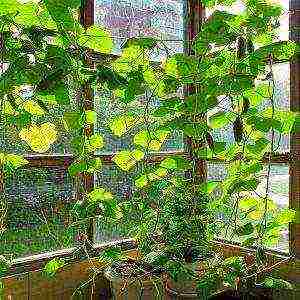 A gardener and a gardener live in every person. With the arrival of the first spring heat, everyone is drawn to the dacha, to the village, to the garden. It's nice to dig in the fresh soil, breathe in its aroma and throw the first seeds on the garden bed. But not everyone is lucky to meet spring on their own piece of land. Many townspeople do not have time for a trip to the garden or their own garden. This is fixable. If it is not possible to go to the garden, then it can be built at home on the balcony or windowsill. In small homemade beds, you can grow radishes, green onions, tomatoes, cucumbers. The latter vegetable requires special attention and care. To get a rich harvest, you need to know how to properly grow cucumbers on the windowsill and balcony and not harm the plant. Due to inexperience, its tender sprouts can be destroyed within a few hours. But if you choose the right land mixture, capacity, variety, adhere to the temperature regime, then the green vine will thank you with tender, crispy cucumbers.
A gardener and a gardener live in every person. With the arrival of the first spring heat, everyone is drawn to the dacha, to the village, to the garden. It's nice to dig in the fresh soil, breathe in its aroma and throw the first seeds on the garden bed. But not everyone is lucky to meet spring on their own piece of land. Many townspeople do not have time for a trip to the garden or their own garden. This is fixable. If it is not possible to go to the garden, then it can be built at home on the balcony or windowsill. In small homemade beds, you can grow radishes, green onions, tomatoes, cucumbers. The latter vegetable requires special attention and care. To get a rich harvest, you need to know how to properly grow cucumbers on the windowsill and balcony and not harm the plant. Due to inexperience, its tender sprouts can be destroyed within a few hours. But if you choose the right land mixture, capacity, variety, adhere to the temperature regime, then the green vine will thank you with tender, crispy cucumbers.
The best varieties of cucumbers for growing on a windowsill
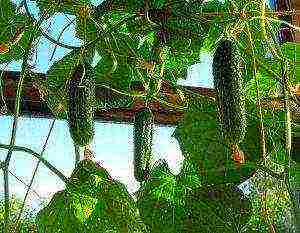 If you choose the right varieties of cucumbers, then on the windowsill you can get a harvest that is much richer than what a neighbor grows up in the country. Fans of home gardening should pay attention to the hybrids of the F1 group:
If you choose the right varieties of cucumbers, then on the windowsill you can get a harvest that is much richer than what a neighbor grows up in the country. Fans of home gardening should pay attention to the hybrids of the F1 group:
- Natasha F1;
- Marinda F1;
- Masha F1;
- Fontanelle F1.
The last variety can be safely called a cucumber masterpiece of Moldovan breeders. For several decades, he successfully pleases his owners with generous fruiting, resistance to diseases.
Of the usual varieties for indoor cultivation, cucumbers are suitable:
- Thumb Boy;
- Smear;
- Stella.
They are light-requiring and require cross-pollination, but they have high yields, resistance to diseases in an enclosed space.
Parthenocarpic hybrids are the best varieties of cucumbers for planting on the windowsill, as they set fruits regardless of the weather, temperature fluctuations, sunlight, have a large number of female self-pollinated inflorescences, do not require special conditions of detention.
The main rules for healthy cucumber seedlings
The key to a rich harvest is high-quality seedlings. In order for the seeds to sprout quickly, several important rules must be followed:
- The sowing soil must always be sterilized. Do not trust purchased mixtures: they can be infected with bacteria and pests. The earth should be good for air permeability and absorb moisture. It is good if the soil does not contain many trace elements. At this stage, the plant does not need them in large quantities. A mixture of peat and river sand is best suited for sowing cucumbers.
- Do not plant freshly harvested cucumber seeds. These plants are dominated by male flowers that do not set fruit. Five-year-old seeds produce the largest number of female inflorescences.
- The seeds, covered with a special multi-colored shell, germinate much later and require constant moisture. When the soil is overdried or underfilled, the plant may die while still in the soil.
- It is better to grow seedlings in small cups or peat tablets, and after the appearance of the third true leaf, transplant them into a large container.
- The optimum temperature for the emergence of seedlings is 22 degrees with high humidity. To achieve a similar effect, you need to spray the room three times a day, or keep a damp cloth under the cups with seedlings.
- After the first shoots appear, it is necessary to slightly lower the room temperature, humidity, and increase the amount of sunlight.
- To prevent young shoots from stretching, illumination with a fluorescent lamp is necessary. The help of lamps is also necessary before laying the buds on cloudy days (hybrids can do without backlighting).
- Watering with warm, settled water will help the plant absorb moisture faster.
After the appearance of the first true leaf, the seedlings can be fed with liquid nitrogen, potassium fertilizer. It is important to ensure that water and liquid with trace elements do not get on the leaf during the daytime. A drop of moisture can cause burns.
Cucumber planting utensils
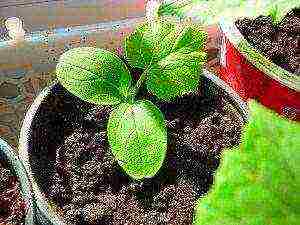 To grow cucumbers on a windowsill, you need to choose the right container. Then the plant will feel comfortable all season. Cucumber roots are located shallow from the soil surface and love to be warmed up by the sun and watered by warm rain. For one plant, a 5-liter plastic bucket or pot will suffice. It is good if its width predominates over its height.
To grow cucumbers on a windowsill, you need to choose the right container. Then the plant will feel comfortable all season. Cucumber roots are located shallow from the soil surface and love to be warmed up by the sun and watered by warm rain. For one plant, a 5-liter plastic bucket or pot will suffice. It is good if its width predominates over its height.
Care rules
Even inexperienced gardeners can follow the rules for caring for cucumbers on the windowsill. The main thing is to strictly follow the instructions and not rely on "maybe".
- Cucumbers love diffused sunlight. On the southern window, their leaves will burn from the heat, and on the western window, the stems will stretch out, most of the fruits will have a characteristic, pear-shaped shape.
- It is better to water the plants after sunset or in cloudy weather under the root, along the edges of the pot.
- The soil for adult plants can be similar to that used for sowing seeds, with the addition of potash, phosphorus, nitrogen fertilizers, wood ash. When landing in a permanent place, drainage should be built. If there is no expanded clay at hand, then you can use ordinary pebbles or break ordinary foam into small pieces.
- After the appearance of the fifth leaf, the plant needs support. You can stretch a special net along the window or tie the whips with ropes. The trellis net on the windowsill looks aesthetically pleasing and is a good support during fruiting.
- In summer, the biggest problem when growing cucumbers on the windowsill is the heat: the percentage of humidity in the room and outdoors decreases, the earthen mixture dries quickly even with frequent watering.Mulching potted soil will help keep the root system from overheating and retain water. Chopped bark, straw, sphagnum moss, sawdust, fresh grass are suitable for mulch.
- When growing non-hybrid varieties, it is recommended to pinch off the top of the plant after 7-8 leaves. This technique will give an impetus to the growth of side shoots, on which a greater percentage of female flowers are located.
- Proper care and cultivation of cucumbers is not only timely watering, high-quality soil, fertilizers, but also regular harvesting. In order for the plant to bear fruit at full strength, it is necessary to collect greens every day. Then he will have the strength to bloom abundantly and set new fruits.
In addition to these recommendations, it is necessary to monitor the condition of the plants, observe how they develop, whether there are signs of diseases and check the quality of the soil in the container.
Growing problems
 It seems that plants in the room are protected from all diseases and pests, but gardeners often face problems against which the most effective drugs are powerless. In most cases, this is a violation of the rules of agricultural technology or a lack of micronutrients.
It seems that plants in the room are protected from all diseases and pests, but gardeners often face problems against which the most effective drugs are powerless. In most cases, this is a violation of the rules of agricultural technology or a lack of micronutrients.
The most common question for many novice gardeners is: why do cucumbers on the windowsill turn yellow leaves?
There are several reasons, but if there are no signs of powdery mildew infection, then this may be untimely watering, stagnation of moisture in the soil (an unpleasant odor from the pot and small black flies appears) or a lack of nitrogen.
When you do everything right, adhere to the advice of experienced colleagues, it is difficult to understand why the cucumbers set, but do not grow. A similar situation is observed when the temperature drops below +16 or in extreme heat. Then the plant sheds fruits or inhibits their growth in order to maintain strength.
Everyone can grow cucumbers on the windowsill. The main thing is not to be afraid to make a mistake and love the business you are doing. And the reward for your efforts will be new knowledge and a crispy cucumber for lunch.
Cucumbers on the windowsill - video
Waiting for spring is not so tiring if you find something to your liking. For example, grow cucumbers on a windowsill. If there is additional lighting, you can sow cucumber seeds in an apartment already in January, if not, postpone sowing for February or March. But it's worth now to prepare everything you need, to choose varieties and hybrids of cucumbers suitable for apartment conditions.
Leading suppliers of cucumber seeds helped us compile a list of the best indoor cucumber varieties and hybrids. The general requirement is shade tolerance, because even in the southern window the plants will be much less illuminated than in the greenhouse. For other parameters, different solutions can be chosen.
Choosing varieties and hybrids of cucumbers for growing on a windowsill.
Olga Baklanova, cucumber breeder, Poisk company
When choosing varieties and hybrids for growing in an apartment, you need to take into account not only their shade tolerance. There are other important qualities:
- The combination of high night temperatures (battery under the windowsill!) And low light (short day and cloudy weather) can increase the number of male flowers on the plant and, therefore, reduce the number of potential greens. Therefore, you need to choose the most hardy and unpretentious.
- It is worth avoiding thickened plantings and shading of plants with each other.
- Both bee-pollinated cucumbers and parthenocarpics are suitable for the windowsill. Of course, manual pollination will be necessary first, but on the scale of a windowsill, these are mere trifles.
For early sowing without additional lighting (around mid-February), cucumbers are suitable:
F1 Forward, F1 Faust - smooth parthenocarpic hybrids. Their distinctive feature is increased shade tolerance plus high taste and marketability of zelents. These hybrids bear fruit well under short day conditions and a lack of light.
F1 Forward - a tall plant. The branching is weak, which makes it easier to care for.
Faust F1 - also tall, medium branching, female flowering type.
When sowing at a later date (early or mid-March), try parthenocarpic hybrids F1 Arbat and F1 Flagship... They combine early maturity (up to 45–47 days from germination) and productivity with excellent taste and unique cucumber aroma of crunchy lumpy fruits.
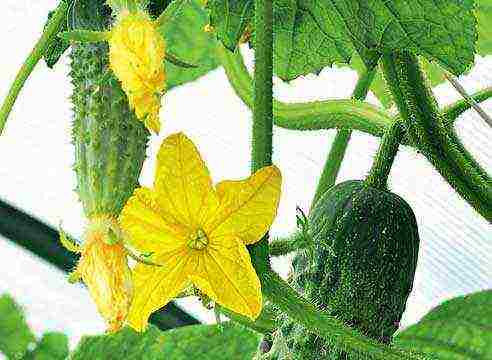
Sergey Dubinin, head of SeDec company
We recommend growing parthenocarpic hybrids on a windowsill. In our assortment there are not only shade-tolerant, but also with a very high stress resistance. This quality is important, because the air in the apartment is dry, drafts and a small volume of soil in which the plants are planted dries quickly. Choose hybrids with the type of fruit you like best.
In early spring, salad cucumbers with a smooth skin without pimples usually go with a bang. Very sweet and fragrant fruits in hybrids: F1 Window-balcony, F1 Galina, F1 Elizabeth (the latter has rare tubercles on the fetus).
Lovers of small lumpy fruits (in a "German shirt") will suit unpretentious F1 Patty and F1 Diva with a bundle arrangement of the ovary and crispy cucumbers that are not bitter under any growing conditions. They are good not only fresh, but also pickled.
If you think a cucumber is not a cucumber without real pimpled skin, choose F1 Russian style... It begins to bear fruit very quickly (45–48 days from germination) and is resistant to root rot - an important quality when growing cucumbers in the cold season, even if in an apartment.
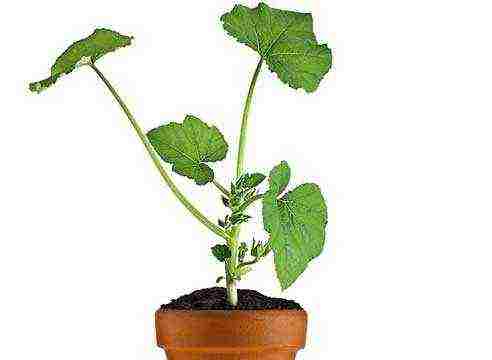
Oleg Krylov, breeder, Manul company
For indoor cultivation, I recommend choosing varieties and hybrids with good branching ability. The height of the window usually allows the cucumber to produce only 6-7 leaves from the base of the stem to the top of the window frame. When the plant bears fruit on this part of the shoot, it forms side lashes, from which it will be possible to harvest additional crops.
The most shade-tolerant cucumbers are winter bee-pollinated hybrids, bred specifically for growing in year-round greenhouses. Suitable for sowing in the second half of February: F1 Relay, F1 Olympics, F1 Manul, F1 Marathon with a predominantly female flowering type. They need to be manually pollinated, but their taste and simplicity are worth it. The listed hybrids usually form enough male flowers for pollination, but for safety reasons it is still better to plant one pollinator plant. It can be any variety or hybrid with a male flowering type, for example, Phoenix.
It is more convenient to grow parthenocarpics on a windowsill, since they do not need pollination, but they are generally more sensitive to a lack of lighting, so it is advisable to sow them already in March. The most shade-tolerant, in my opinion, parthenocarpic hybrid - F1 TLC 442... In addition, hybrids with increased shade tolerance and bunch type of fruiting are suitable for March sowing: F1 Moscow evenings, F1 Maryina Roshcha, F1 Chistye prudy, F1 Secret of the firm, F1 Hit of the season.
Anna Shamshina, cucumber breeder, Gavrish company
We have very shade tolerant hybrids F1 Courage (parthenocarpic) and F1 Athlete (bee-pollinated), recommended for growing on a windowsill. Both with a bundle arrangement of ovaries. They differ not only in excellent taste and resistance to diseases, but also in average shoot-forming ability, which is convenient for forming on the windowsill. At first, the plant goes into one stem, does not branch, does not shade itself, which is important when there is a lack of light. When fruit forms on the main stem, it produces lateral shoots that need to be pinched over the second node. An additional crop is formed on the side shoots.
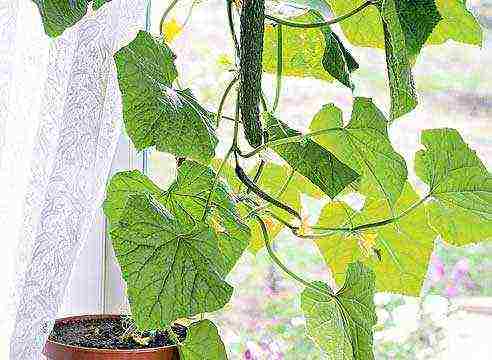
Container for growing cucumbers on the windowsill
For cucumber growing, select a container with a capacity of at least 5 liters per plant.The root system of a cucumber does not tolerate waterlogging or drying out of the soil, when the concentration of the soil solution sharply increases. The larger the pot, the easier it will be to maintain a constant water-salt regime, in other words, keep the soil moderately moist.
Soil for cucumbers
Light fertile soil with a high content of organic matter and a pH of 6.3-6.8 is suitable for cucumbers. You can buy ready-made high-quality soil for cucumber seedlings or prepare one of the recommended potting mixes yourself:
- garden soil (loam), peat, humus (4: 1: 1), add half a glass of wood ash to 5 liters of the mixture and 1 tbsp. l. full fertilizer, 1 tsp. magnesium sulfate;
- sod or garden land (loam), vermicompost (1: 1), 3 tbsp. l. wood ash per 5 liters of the mixture;
- peat, humus, sawdust, turf or garden soil (2: 2: 1: 2), half a glass of wood ash, 1 tsp. magnesium sulfate and 1 tbsp. l. complete fertilization per 5 liters of the mixture.
Sowing cucumbers
Fill the container with soil, 3-4 cm short of the edge. The soil should be slightly moist but free flowing. If the seeds are not expensive, sow 3 seeds at once in one hole, at a distance of 1-2 cm from each other. The seeding depth is 2-3 cm. Seeds pretreated with stimulants and or microelements (as in the photo) are sown dry. Ordinary seeds can be hardened first by keeping them in a damp cloth in the vegetable compartment of the refrigerator for two days. This will increase their resistance to stress and cold (in winter and early spring, the potted soil on the windowsill can get very cold). It is for this reason that it is better not to sow cucumbers on the windowsill with "naklevysh", as is usually done in the summer in the garden with a sufficiently warm soil.
More details: How to prepare cucumber seeds for sowing
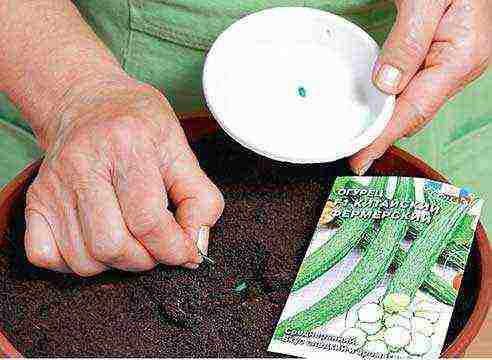
Water the seed hole.
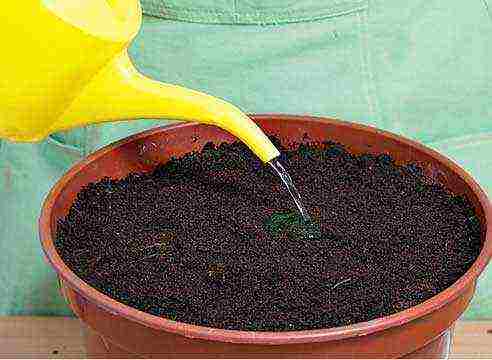
Cover the pot with glass or a plastic bag and put it in a warm place with a temperature of + 25 ... + 30 ° C before sprouting (for example, under the kitchen ceiling). As soon as shoots appear, remove the shelter, move the pot to the windowsill. It is advisable to put a heat-insulating material (for example, foam plastic) under it. Make sure that no drafts fall on the plant.
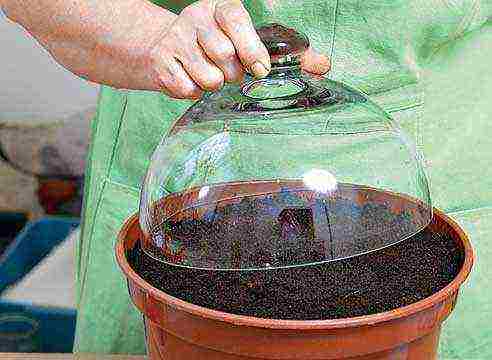
When the first true leaves appear, we thin out the seedlings. You need to leave one of the largest, remove the rest.
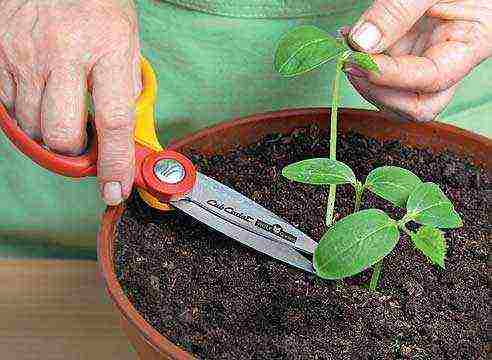
Use twine as a support for the lash. As the stem grows, it is wrapped around the support.
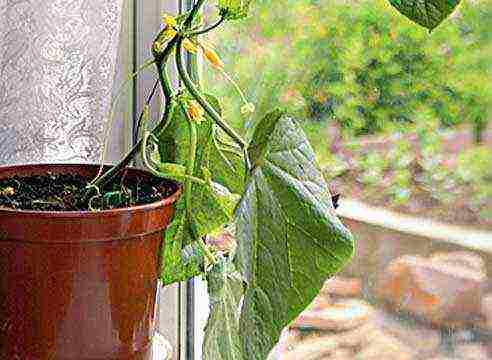
Feed the plant with seedling fertilizer every 10-14 days as instructed. Be careful: if the fertilizer is applied to both potted plants and vegetables in the ground, the feeding rates for growing in containers should be 10 times lower, otherwise the fertilizer may burn the roots. Cucumbers prefer organic-mineral or organic fertilizers - for example, infusion of mullein or horse manure.

When 5-6 nodes appear on the main shoot, pinch the top. If lateral lashes grow on the plant, they need to be pinched over the second knot.

Is it difficult to grow cucumbers on a windowsill? The technology of growing at home is simple and suitable even for a novice grower. First of all, you need theoretical knowledge of care, and experience will come after the first cultivation in an apartment, on a window.
History of the origin of culture
Cultivation of cucumbers as a vegetable crop began 5000 years ago in India, in which they still grow in natural conditions. In ancient Egypt, Greece, Rome, this vegetable was already eaten. In the Middle Ages, it spread throughout Europe.
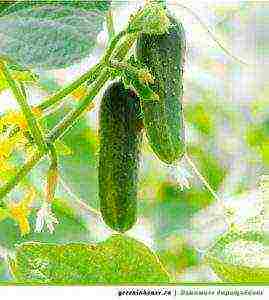 The common cucumber, a close relative of the pumpkin, belongs to the Pumpkin family, and the fruit is called so - pumpkin. The stem is creeping, branching, reaching a length of 1 - 2 meters, with multiple antennae clinging to the support. Leaves of various shapes, flowers are yellow. Fruits are smooth or pimpled, with many seeds, in the overwhelming majority of cases they are green, but there are white, brown, yellow. Taproot with numerous lateral superficial roots.
The common cucumber, a close relative of the pumpkin, belongs to the Pumpkin family, and the fruit is called so - pumpkin. The stem is creeping, branching, reaching a length of 1 - 2 meters, with multiple antennae clinging to the support. Leaves of various shapes, flowers are yellow. Fruits are smooth or pimpled, with many seeds, in the overwhelming majority of cases they are green, but there are white, brown, yellow. Taproot with numerous lateral superficial roots.
back to content ↑ What varieties to choose for the home?
Cucumbers grow on the beds, with male and female flowers blooming on lashes. When the female flowers are pollinated with pollen, fruits are produced. It is difficult to grow such varieties at home on the window: there are no pollinators, in addition, they often grow stunted at home. You will have to manually pollinate indoor cucumbers. When the pollen is ripe on the male flowers located on the main shoot, it is transferred to the stigma of the pistil of the female flowers located on the lateral shoots. This procedure will have to be done several times for each flower. Ideal cucumbers on the windowsill are parthenocarpic varieties, in which the ovaries of female flowers turn into fruits without the participation of pollen. Parthenocarpic cucumbers do not produce seeds. Therefore, the seeds of favorite cucumbers must be purchased again. The F1 index, which is often found on the packaging when buying, indicates the first generation seeds obtained by crossing two varieties. Hybrids are more fertile, disease resistant, hardy.
Of the parthenocarpic varieties, disease-resistant, fruitful varieties Balkonnoe Miracle F1, Zozulya F1, Dragonfly F1, Courage, Connie F1, Katya, Orfey-F1, Anyuta, Ajax F1, Angel F1, and many others are recommended for home. Care for them is the same as for pollinated ones.
Shrub varieties, compact, fertile and early ripening, unfortunately difficult to grow at home, they are intended for open ground.
To try the first greenery within 30-45 days after germination, early ripening varieties are chosen. Many of these fruit quickly and stop growing. With proper care, mid-ripening (ripening in 45-50 days) and late-ripening (more than 50 days) varieties give longer fruit.
back to content ↑ Selection and planting of seeds at home
At home on the windowsill, cucumbers can be grown all year round. However, planting in an apartment in the spring gives better results and caring for such plantings is easier.
It is very important for a good harvest to choose quality seeds. 3-4-year-old seeds have the best germination, and 1-2-year-old seeds and older than 5 years germinate much worse. Well-known firms take this feature and many other factors into account, and their products show good germination and viability. Therefore, preference should be given to reputable trading companies and look at the date of packaging.
To disinfect seeds, you need to do the following: take a 1-2% solution of potassium permanganate and keep the seeds in it for at least half an hour. Plasma and nutrient-coated seeds do not require processing.
The seed germination technology can be different. They are kept for several days in a wet cloth or paper until small roots appear, followed by planting, or placed immediately in wet soil. When moving naklyuvanny seeds, you must be careful not to damage the very tip of the root. A broken root in the early stages is fatal. For the same reason, they try not to transplant the plant and immediately plant several seeds in a permanent place. Placed in the substrate shallow (1-2 cm), with the narrowed part down. When sprouts appear on the surface, the strongest is left.
back to content ↑ Conditions for growing cucumbers
For successful fruiting, you need to choose a suitable pot and prepare a fertile soil.
Containers take at least 5 liters: the root system must be developed to ensure a continuous and constant flow of nutrients to the aboveground part of the plant. The pot is selected so that it fits the interior of the house. The store has a large selection of containers suitable in color, size and texture. With creativity and imagination, you can make a pot with your own hands from used plastic bottles. Such an original object will be a decoration of the house and the pride of the owners. It is imperative to make holes in plastic bottles for water to drain.
The soil is prepared from humus (rotted manure) with the addition of leafy earth, peat (coconut fiber), sand (1: 1.5: 1: 2) with the addition of a handful of ash per 5 liters of soil. Instead of sand, it is permissible to use sawdust. The substrate should be light, loose, with slightly acidic or neutral acidity.
back to contents ↑ How to grow cucumber seedlings on the window?
Small cups (cut plastic bottles) are selected for seedlings. The disadvantage of growing in intermediate containers is the possibility of damage to the roots during transplantation, the advantages are the choice of the best specimens and additional planting if the seedlings are gone.
When transplanting, the seedlings are buried to the cotyledonous leaves for the formation of additional roots. In the case of growing a seedling in a permanent place, the soil is filled up in the same way.
Young plants are sensitive to water overflow and the main thing in caring for them is careful watering, otherwise decay is inevitable. With the growth of the cucumber, watering is increased and fed once a week with complex mineral fertilizers. If there is not enough water during the formation of greens, they fall off or become bitter. The development of cucumbers is suspended when there is a shortage of phosphorus and potassium, therefore, when feeding, their content should be increased.
To humidify the air, use trays with always wet fillers and electric humidifiers. The room temperature of the content is optimal and is in the range of 18-25 ° C.
For plants to grow fully, good lighting is needed 12-14 hours a day. When the lighting is insufficient on rainy and winter days, artificial lighting with fluorescent lamps and LEDs is used. Plants do not light up in late spring and summer.
to the content ↑ Plant formation and yield
Shoots are allowed upward along the trellises or along the twine stretched to the top of the window. The loops are reinforced between the second and third sheets and attached to the twine or trellis. They should be loose so as not to damage the stem. Coarse mesh is good for summer. She will protect the plant from direct sun, and the tendrils of cucumber lashes cling to her and do not need a garter.
Some varieties (Bettina and others) are formed by themselves, they have genetically predetermined the formation of the bulk of the crop on the central stem and they grow with one stem.
The standard technology of crown formation involves a mandatory procedure: in the axils of the first three leaves, all flowers and shoots are removed. And then they either allow the liana to grow freely, or sequentially pinch the lateral shoots, leaving several ovaries each. When the main shoot reaches the top edge of the window, pinch it.
2 months after sowing, the cucumber begins to bear fruit on the window. Zelentsy appear in most varieties on lateral shoots. In one bosom there can be from 1 to 10. It is difficult to get a bouquet harvest at home, but one ovary grows quickly and gives a full-fledged cucumber. Top dressing, watering, air humidification, full-fledged lighting prolong the growing season at home and side shoots will give a good yield, declared for the variety.
As you can see, caring for cucumbers on the windowsill at home is easy to carry out in practice. It is necessary to do all the actions necessary for the successful ripening of the fruits and in good conditions, when the greens ripen, you can eat an ecologically clean product grown by your own hands.
Similar articles:


